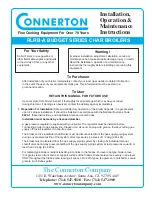
18
Compact
SECTION 6 SERVICING INSTRUCTIONS
6.1
GENERAL
To ensure the continued safe and efficient
operation of the appliance, it is recommended
that it is checked and serviced at regular intervals.
The frequency of servicing will depend upon the
particular installation conditions, but in general,
once per year should be adequate.
It is the law that any servicing work is carried out
by competent person such as a Vokera engineer,
an approved service agent, British Gas, or other
CORGI registered personnel.
The following instructions apply to the appliance
and its controls, but it should be remembered
that the central heating system will also require
attention from time to time.
Always use genuine Vokera spare parts
6.2
ROUTINE ANNUAL SERVICING
Check the operation of the appliance in both ‘hot
water only’ and ‘heating and hot water’ modes.
Ensure the appliance functions as described in
section 7. Compare the performance of the appli-
ance with its design specification. The cause of
any noticeable deterioration should be identified
and rectified without delay.
Thoroughly inspect the appliance for signs of
damage or deterioration especially the flue sys-
tem and the electrical apparatus.
Check and adjust – if necessary – all burner
pressure settings (see section 7.6).
Check and adjust – if necessary – the system
design pressure (see section 5.11).
Carry out an analysis of the flue gases (see
section 7.7), and visually check the condition of
the entire flue assembly. Compare the results
with the appliance design specification. Any
deterioration in performance must be identified
and rectified without delay.
Ensure both flue venturis are clean and free from
any debris or obstruction.
Ensure both the burner and heat exchanger are
clean and free from any debris or obstruction.
Inspect all joints for signs of leakage and repair if
necessary.
Refer to the commissioning section and/or re-
placement of parts section for detailed instruction
if required.
6.3
REPLACEMENT OF COMPONENTS
Although it is anticipated that this appliance will
give years of reliable, trouble free service, the life
span of components will be determined by fac-
tors such as operating conditions and usage.
Should the appliance develop a fault, the fault
finding section will assist in determining which
component is malfunctioning.
6.4
MAIN HEAT EXCHANGER (de-scaling)
The main heat exchanger may – when operating
under certain conditions – become affected by
scaling. Evidence of this will be a deterioration of
the hot water performance. The heat exchanger
can be de-scaled using a proprietary de-scalant
without having to remove it from the appliance.
However the appliance must be disconnected
from the hot and cold service pipes, the de-
scalant should be administered with strict adher-
ence to the manufacturers instructions. Re-
connect the hot and cold services only after
thorough flushing with clean water has taken
place.
6.5
COMPONENT REMOVAL PROCEDURE
To remove a component, access to the interior of
the appliance is essential. Isolate the appliance
from the electrical supply and remove the fuse.
And when necessary, close all service valves on
the appliance, remove the appliance casing as
described in section 4.7.1, drain the primary
water content from the appliance via the safety
valve, and drain off secondary water content from
the appliance via a hot water outlet. Ensure some
water absorbent cloths are available to catch any
residual water that may drip from the appliance or
removed component. Undertake a complete
commissioning check as detailed in section 5,
after replacing any component. ALWAYS TEST
FOR GAS SOUNDNESS IF ANY GAS CARRY-
ING COMPONENTS HAVE BEEN REMOVED
OR DISTURBED.
6.6
PUMP HEAD fig. 16
Carry out component removal procedure as de-
scribed in section 6.5.
Using a 4 mm Allen key or ‘T’ bar, unscrew and
remove the four Allen screws that hold the pump
in position, pull firmly on the pump head to release
it from the base. Disconnect the electrical leads.
Replace in the reverse order.
6.7
SAFETY VALVE fig. 16
Carry out component removal procedure as de-
scribed in 6.5.
Disconnect the outlet pipe from the safety valve,
unscrew and remove the hex bush from the
safety valve outlet, remove safety valve locking
pin from appliance manifold. Replace in the
reverse order
Fig. 16
Pump
Safety valve
















































